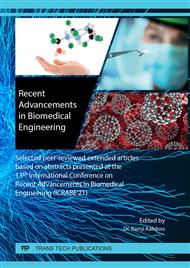[1]
Spook W. Lean compounding: the key to survival. Plastics, Additives and Compounding 2008;10:26–9. https://doi.org/10.1016/S1464-391X(08)70132-6.
DOI: 10.1016/s1464-391x(08)70132-6
Google Scholar
[2]
Van Cauwenberghe, Lisbeth, and Colin R. Janssen. Microplastics in Bivalves Cultured for Human Consumption. Environmental Pollution 193, (2014), 65–70. https://doi.org/10.1016/j.envpol.2014.06.010.
DOI: 10.1016/j.envpol.2014.06.010
Google Scholar
[3]
E. C. Achilleos, G. Georgiou, and S. G. Hatzikiriakos, Role of Processing Aids in the Extrusion of Molten Polymers, Journal of Vinyl and Additive Technology 8, (2002), 7–24. https://doi.org/10.1002/vnl.10340.
DOI: 10.1002/vnl.10340
Google Scholar
[4]
Rwei, Syang-Peng, Distributive Mixing in a Single-Screw Extruder?Evaluation in the Flow Direction, Polymer Engineering & Science 41, (2001), 1665–73. https://doi.org/10.1002/pen.10864.
DOI: 10.1002/pen.10864
Google Scholar
[5]
U. Saeed, S. Ahmad, J. Alsadi, D. Ross, and G. Rizvi, Implementation of Neural Network for Color Properties of Polycarbonates, 56–59. Nuremberg, Germany, 2014. https://doi.org/10.1063/1.4873733.
DOI: 10.1063/1.4873733
Google Scholar
[6]
Hao, Zhimin, and A. Iqbal, Some Aspects of Organic Pigments, Chemical Society Reviews 26, (1997), 203. https://doi.org/10.1039/cs9972600203.
Google Scholar
[7]
Kitayama, Satoshi, R. Ishizuki, M. Takano, Y. Kubo, and S. Aiba, Optimization of Mold Temperature Profile and Process Parameters for Weld Line Reduction and Short Cycle Time in Rapid Heat Cycle Molding, The International Journal of Advanced Manufacturing Technology 103, (2019), 1735–44. https://doi.org/10.1007/s00170-019-03685-3.
DOI: 10.1007/s00170-019-03685-3
Google Scholar
[8]
R. Y. Jumah, B. Tashtoush, R.R. Shaker, and A.F. Zraiy, Manufacturing parameters and quality characteristics of spray dried jameed, Drying Technology 18, (2000): 967–84. https://doi.org/10.1080/07373930008917747.
DOI: 10.1080/07373930008917747
Google Scholar
[9]
Shah, L. Pravin, Melt Rheology and Its Role in Plastics Processing, Journal of Vinyl and Additive Technology 3, (1997), 97–98. https://doi.org/10.1002/vnl.10172.
DOI: 10.1002/vnl.10172
Google Scholar
[10]
W. K. A. Ma, F. Chinesta, A. Ammar, and M. R. Mackley, Rheological Modeling of Carbon Nanotube Aggregate Suspensions, Journal of Rheology 52, (2008), 1311–30. https://doi.org/10.1122/1.2982932.
DOI: 10.1122/1.2982932
Google Scholar
[11]
J. Al Sadi, and A. Hawary, The Ideal Temperature Setting of Polymer Blends: Investigational Characterization Effects of Color Matching, IOP Conference Series: Materials Science and Engineering 1194, (1, 2021), 012003. https://doi.org/10.1088/1757-899X/1194/1/012003.
DOI: 10.1088/1757-899x/1194/1/012003
Google Scholar
[12]
Tran, Ngoc-Thien, and N. T. H. Pham, Investigation of the Effect of Polycarbonate Rate on Mechanical Properties of Polybutylene Terephthalate/Polycarbonate Blends, Edited by Atsushi Sudo. International Journal of Polymer Science (2021), 1–7. https://doi.org/10.1155/2021/7635048.
DOI: 10.1155/2021/7635048
Google Scholar
[13]
Pötschke, Petra, A. R. Bhattacharyya, A. Janke, and H. Goering, Melt Mixing of Polycarbonate/Multi-Wall Carbon Nanotube Composites, Composite Interfaces 10, (2003), 389–404. https://doi.org/10.1163/156855403771953650.
DOI: 10.1163/156855403771953650
Google Scholar
[14]
M. M. K. Khan, Rheological and mechanical properties of ABS/PC blends. Korea-Australia Rheology Journal. 17, (2005), 1-7.
Google Scholar
[15]
Lee, Sukmin, P. T. Mather, and D. S. Pearson, Phase Behavior and Rheology of Blends Containing Polycarbonate and a Thermotropic Polyester, Journal of Applied Polymer Science 59, (1996), 243–50. https://doi.org/10.1002/(SICI)1097-4628(19960110)59:2<243::AID-APP8>3.0.CO;2-X.
DOI: 10.1002/(sici)1097-4628(19960110)59:2<243::aid-app8>3.0.co;2-x
Google Scholar
[16]
Reddy, C. Ravindra, A. P. Sardashti, and L. C. Simon, Preparation and Characterization of Polypropylene–Wheat Straw–Clay Composites, Composites Science and Technology 70, (2010), 1674–80. https://doi.org/10.1016/j.compscitech.2010.04.021.
DOI: 10.1016/j.compscitech.2010.04.021
Google Scholar
[17]
J. Alsadi, U. Saeed, S. Ahmad, G. Rizvi, and D. Ross, Processing Issues of Color Mismatch: Rheological Characterization of Polycarbonate Blends, Polymer Engineering & Science 55, no. 9 (September 2015): 1994–2001. https://doi.org/10.1002/pen.24041.
DOI: 10.1002/pen.24041
Google Scholar



